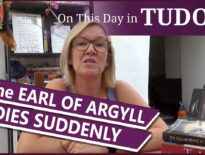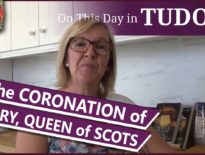On this day in Tudor history, Saturday 10th September 1547, in the reign of King Edward VI, the Battle of Pinkie Cleugh, also known as the Battle of Pinkie, took place near Musselburgh, in Scotland, on the banks of the River Esk. The English forces, led by Edward Seymour, Duke of Somerset, defeated the Scots, killing thousands.
It was a bloody battle, but started off well for the Scots. In today's talk, I share an eye-witness account of how the battle changed so dramatically, leading to the loss of between 6,000 and 15,000 Scots.
Roger Knox's video on the battle:
William Patten's detailed account can be found at https://archive.org/details/tudortracts00polliala/page/106/mode/2up
Also on this day in Tudor history, 10 September 1533, King Henry VIII and Queen Anne Boleyn's daughter, Elizabeth (the future Queen Elizabeth I), was christened at the Church of Observant Friars in Greenwich. Elizabeth I's christening service was a lavish ceremony presided over by Archbishop Thomas Cranmer, who also stood as the little girl's godfather. Find out more about Elizabeth’s christening and the celebrations that followed, in last year’s video:
Also on this day in history:
- 1515 – Thomas Wolsey was made Cardinal.
- 1543 – Death of Sir Edward Chamberlayne, Oxfordshire gentleman and soldier. He was buried at Woodstock.
- 1549 – Death of Sir Anthony Denny, Henry VIII's great friend and groom of the stool, at Cheshunt. He was buried in St Mary's Church, Cheshunt.
- 1557 – Execution of Joyce Lewis (née Curson and other married name Appleby, Lady Appleby), Protestant martyr, at Lichfield. She was burned at the stake for her Protestant beliefs.
- 1569 – Death of Gilbert Bourne, Bishop of Bath and Wells, at Silverton in Devon. Bourne was deprived of his see in Elizabeth I's reign after refusing to take the “Oath of Supremacy”. He was buried in Silverton Church.
- 1604 – Death of William Morgan, Bishop of St Asaph and Bible translator, at the Bishop's Palace at St Asaph. He was buried there in the cathedral church.
Transcript:
On this day in Tudor history, Saturday 10th September 1547, the Battle of Pinkie Cleugh, also known as the Battle of Pinkie, took place near Musselburgh, in Scotland, on the banks of the River Esk. The English forces, led by Edward Seymour, Duke of Somerset, defeated the Scots, killing thousands.
The battle was part of the “War of the Rough Wooing”, so called because it started when Henry VIII tried to force Scotland to stick to the terms of the 1543 Treaties of Greenwich, which included the a marriage between his son Edward, the future Edward VI, and the infant Mary, Queen of Scots. The Earl of Arran, who was acting as regent for Mary, Queen of Scots at the time, had signed the treaties and ratified them in August 1543, but four months later, the Scottish Parliament had rejected the treaties. Henry VIII was furious and eight years of conflict between the two kingdoms began in December 1543 and continued into Edward VI's reign, with Edward Seymour, Duke of Somerset and Lord Protector, continuing Henry VIII's policy of a forcible alliance with the Scots.
The Battle of Pinkie Cleugh is regarded as the last pitched battle between England and Scotland, i.e. a battle where both sides chose to fight at a scheduled time and location. The English forces, led by Somerset, defeated the Scots, led by the Earl of Arran. Somewhere between 6,000 and 15,000 Scots were killed at the battle, compared to 500-600 Englishmen.
William Patten, who accompanied Somerset and his troops to Scotland as Judge of the Marshalcy, wrote a detailed eye witness account of the battle in his pamphlet “The expedicion into Scotlande of the most woorthely fortunate prince Edward, duke of Soomerset”, along with a plan of the battlefield. I’ll give you a link to read it in full, but I’llshare information and excerpts here.
He manages to conjure in our imaginations just how scary a situation this battle was for all concerned, writing:
“Herewith waxed it very hot, on both sides, with pitiful cries, horrible roar, and terrible thundering of guns besides. The day darkened above head, with smoke of shot. The sight and appearance of the enemy, even at hand, before. The danger of death on every side else. The bullets, pellets, and arrows flying everywhere so thick and so uncertainly lighting, that nowhere was there any surety of safety. Every man stricken with a dreadful fear, not so much, perchance of death, as of hurt; which things, though they were but certain to some, were yet doubted of all. Assured cruelty at the enemy’s hands, without hope of mercy. Death to fly, and danger to fight.
The whole face of the field, on both sides, upon this point of joining, both to the eye and the ear, so heavy, so deadly, lamentable, outrageous, terribly confused, and so quite against the quiet nature of man...”
According to Patten, the battle started off well for the Scots with them wounding many of the English cavalry:
“the Scots again caught courage afresh, ran sharply forward upon them, and, without any mercy, slew every man of our men that abode furthest in press; a six more, of Boulogners and others, than I have here named: in all, to the number of twenty-six, and the most part gentlemen.”
He tells of how Lord Grey suffered a pike wound through the mouth and Lord Edward’s horse was fatally wounded.
But then the English archers “pricked them sharply with arrows” and the Scots were shot at by the artillery “with great puissance and vehemency”. And then, according to Patten, the Scots saw the English footmen, who were nearly upon them and who had been hidden before by the cavalry and the dust that the horses had raised.
Patten records “Their Governor… like a doughty captain, took hastily his horse that he might run foremost away...The Earl of Angus and other chief captains did quickly follow, as their Governor led, and with the foremost, their Irishmen. Therewith then turned all the whole rout, cast down their weapons, ran out of their wards, off with their jacks and with all that ever they might, betook them to the race that their Governor began...”
The English men pursued them “and spared indeed but few”.
Patten describes how the ground was thick with pikes, swords, bucklers, daggers and other weapons that the Scots abandoned as they fled the battlefield. He continues with his account:
“Soon after this notable strewing of their footmen's weapons, began a pitiful sight of the dead corpses lying dispersed abroad. Some, with their legs off; some but hamstrung, and left lying half dead: others, with the arms cut off; diverse, their necks half asunder; many, their heads cloven; of sundry, the brains smashed out; some others again, their heads quite off: with a thousand other kinds of killing.
After that, and further in chase, all, for the most part, killed either in the head or in the neck; for our horsemen could not well reach them lower with their swords.
And thus with blood and slaughter of the enemy, this chase was continued five miles in length westward, from the place of their standing, which was in the fallow fields of Inveresk, unto Edinburgh Park, and well nigh to the gates of the town itself, and unto Leith; and in breadth nigh three miles, from the Frith sands, towards Dalkeith southward. In all which space, the dead bodies lay as thick as a man may note cattle grazing in a full replenished pasture. The river ran all red with blood: so that in the same chase were counted, as well by some of our men that somewhat diligently did mark it, as by some of them taken prisoners, that very much did lament it, to have been slain above thirteen thousand. In all this compass of ground, what with weapons, arms, hands, legs, heads, blood, and dead bodies, their flight might have been easily tracked to each of their three refuges.
And for the smallness of our number, and the shortness of the time, which was scant five hours, from one to well nigh six, the mortality was so great, as it was thought, the like aforetime had not been seen.”
Patten also notes that the English were more merciful:
“And yet, notwithstanding all these our just causes and quarrels to kill them, we showed more grace, and took more to mercy, than the case on our side, for the causes aforesaid, did well deserve or require.”
The imperial ambassador, François van der Delft, also recorded the battle in a dispatch to Mary of Hungary. He was not an eye-witness, his information came from William Paget, 1st Baron Paget. He wrote:
“On the following day, which was the 10th of this month, when the Protector was advancing towards the said mountain, he heard that the enemy was approaching him in order of battle; and he sent out his cavalry to skirmish with them. Upon their approach the advance guard of the enemy, who were on horseback, dismounted, and crossing their lances, which are in the same fashion as pikes, they stood together in such close order that the English could not do them much harm. The two forces were all the while marching towards each other until they were so close that they exchanged shots. The Protector then decided to send the Earl of Warwick with a good body of horse to take the enemy in the rear, and in order to carry out this operation more unobservedly, he took advantage of the wind and had some smoky fires lit. This enabled the Earl of Warwick to surprise the rear guard of the enemy who were so completely taken unawares that after making a very slight resistance they took to flight, the conclusion being that those who began the panic were those who have an understanding with the Protector. When the rest of the enemy's army saw their rear guard in full flight they followed its example, and they were so actively pursued by the English that there were some fifteen thousand of them either killed or taken prisoners, the Earl of Huntley being amongst the latter: he having been in command of the rear guard, and one of the principal of the Scottish nobles. When this Earl was led to the Protector's tent he said that all the Scottish nobility had been undone on that day, and that with two thousand horsemen the English might range whithersoever they pleased.
The Governor (the Regent Arran) who led the battle escaped, and from what I can understand George, Earl Douglas, who formerly belonged to the (English) King's party, but had afterwards assumed another attitude, did his best for the advantage of the English during the engagement. On the same day that this battle was fought the King's (of England) ships with other vessels loaded with victuals entered the port of Leith, whither it is believed that the Protector has gone, and has sent a part of his forces with his Scottish adherents to take the city and castle of Edinburgh, where it is presumed that the Regent has taken refuge.”
It may have been a victory for the English forces this time, but Scotland still refused to recognise the Treaties of Greenwich. The War of the Rough Wooing was finally brought to an end by the Treaty of Boulogne in March 1550.



Leave a Reply